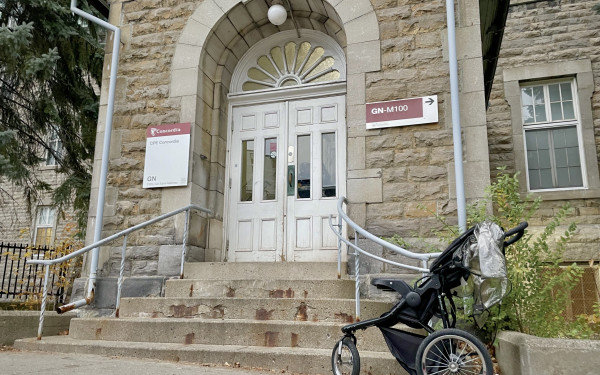Document, Decoded
An In-Depth Look At The Student Centre Contract between ConU and the CSU
The Concordia Student Union has no Plan B.
Plan A? A contract signed in 2009, which the administration has called “the roadmap” into the future of our student centre.
But acknowledging that the current 79-page contract between the CSU and Concordia administration “isn’t perfect” over the weekend, VP External & Projects Adrien Severyns set out to explain some of its stipulations regarding the operational cost, ownership and terms of agreement.
The $10 Million Question
Under the 2009 agreement between the CSU and the administration, students are set to put up $10 million towards the down payment of a student centre by Sept. 1, 2012, in banked fees collected since 2003.
If the referendum to incrementally increase the fee-levy doesn’t pass in the present election, Severyns said that the CSU should still be able to move on the acquisition of the building.
“The current $2 fee levy will end by 2014,” he said. “We now have roughly $7 million in the bank. Depending on the cost of the options we’re looking at, the $10 million should be there [by 2012].”
The increased fee levy is necessary for the CSU to pay their portion of the long-term projected annual acquisition and operating costs—currently slated at a total of $2.6 million per year—he explained.
“By 2014, if we do acquire the $10 million, it will enable the down payment. This [current] fee levy is absolutely necessary for the operating costs, and this is why we’re stressing it,” he said. “How do you expect to maintain and operate this building?”
Severyns said that, if the money doesn’t come together, he is confident that “a solution will have to be found,” and students will not be on the hook for the $10 million down payment in 2012, as the objective is to have the university and the student body “working together in good faith” to acquire a building.
“If the referendum doesn’t pass, it simply means it will take longer for the CSU to accumulate that money,” said Concordia spokesperson Chris Mota. “The plan is to continue discussing with the CSU and trying to make this thing work. There’s no discussion on anyone being ‘on the hook’ for anything; it’ll just be a delayed project if that’s what it comes down to.”Who Owns the Dang Place?
Throughout the SUB campaign, the CSU was resolute in the stance that the building would give students a greater part of decision-making power and autonomous ownership over student space.
In the 2009 agreement, however, Article 1.32 “WHEREAS: The University is/will be the owner of the immoveables that will comprise the Student Centre” is a clause located at the bottom of the very first page.
This stipulation negates student ownership of the centre entirely, but the rest of the articles set out a shared management and operational plan, as well as a shared cost analysis.
CSU executives, past-and-present, have explained that the reason the university owns 100 per cent of the building is “for tax and insurance purposes.”
Beyond this first article, the CSU’s “Proportionate Share Value” is slated at 62 per cent, which is also indicative of the student portion of power on the Board of Co-Management—a committee to control the operations of the building made up of three CSU and two University appointees.
“The centre will be run and owned by students, who will have a majority of the board and the final say on decisions no matter what happens,” said Severyns. “I believe that it is understood that the students will always have the upper hand. At the end of the day, no matter what the decision is, it can be overruled by students.”
However, Article 4.11 sets out a list of regulating policies that would require unanimous approval by the Board of Co-Management, limiting students control over many Student Centre decisions.
Veto Power
Answering concerns that unanimous approval may limit CSU veto rights in decisions, the administration stressed that there are only “a handful of issues” that both parties that signed the contract “believed was of sufficient importance to merit unanimity.”
These issues include, protection of the building, the budget and reserve fund, specific operating projects, maintenance, repair and replacement of common infrastructure, financial records, the re-allocation of space, expense payments and “rules and regulations applicable to the Student Centre to the extent not covered by applicable policies.”
Also stipulated in Article Four is a provision that, if the administration’s share of the building increases to 50 per cent at any time over the 40-year term of the contract, they are also entitled to an additional board member, rounding it out.
“It’s very simple math,” continued Severyns. “But we’re starting the project with three students. Any allocation of space, at the end of the day, is the choice of students in the future because they’ll be able to veto these agreements. It’ll be almost impossible for the re-allocation of space to become 50/50—extremely unlikely—unless we give it to them.”
In the event that any decision cannot be reached unanimously, the Board can mediate with a “Resolution Committee” that would allow both the CSU and Concordia University to appoint two people to come to an agreement.
“The goal is to facilitate and find solutions, so no one has an upper hand,” said Mota.
The Future of the Centre
Whether or not the fee levy increase passes during this week’s referendum period, a student centre may be an inevitable project, with the 2009 contract leading future discourse.
For the CSU, renegotiation is always a possibility.
“The contract is subject to change,” said Severyns. “Obviously we will have minor adjustments to be made here and there. But overall, I believe these changes will be looked into when the project is up and rolling, when we secure funding.”
Mota said she would not assume that this is the case.
“As far as [the administration] is concerned, the agreement is the roadmap. Both parties have agreed to this, they’re moving forward,” said Mota. “Now it’s a question of whether or not the funding will be there. The timeline might have to be adjusted, but it’s also a question of selecting, purchasing and acquiring the location.”
This article originally appeared in Volume 31, Issue 15, published November 23, 2010.


_600_832_s.png)

__600_375_90_s_c1.jpg)

